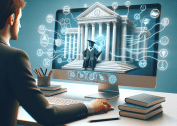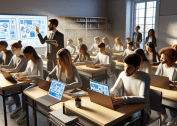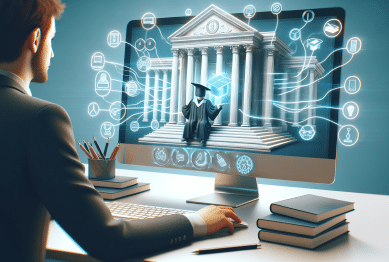Explore how evolving technology, global shifts, and changing learner priorities are reshaping the future of education. Uncover emerging trends and tools in digital learning, equity, and workforce readiness that are influencing students and educators in ways that may surprise you.
Why Digital Literacy Is Becoming Essential
Digital literacy is now seen as a key skill set for success in both education and the workforce. Schools increasingly embed technology use in daily learning to ensure students are not just passive consumers but active creators online. Navigating online platforms, working collaboratively with digital tools, and critically assessing information sources are all components of digital competence. With more classrooms integrating remote and blended learning, being digitally literate allows students to fully participate in all aspects of modern education and opens up opportunities beyond traditional boundaries.
It’s not just about using computers or tablets. Digital skills involve understanding cybersecurity, discerning trustworthy sources, and communicating effectively across multiple platforms. As more educational resources, from STEM projects to global collaboration, depend on digital tools, students who master these skills position themselves ahead in a rapidly changing job market. Teachers, too, must adapt by continually updating their skills so they can guide learners safely and effectively in the digital world.
Many institutions now require digital portfolios and online assessments as standard. This shift benefits learners who become comfortable demonstrating competencies outside traditional exams. Plus, digital literacy enables learners to access a wider range of online resources such as free courses from major platforms (Source: https://www.edx.org) and participate in virtual internships. It invites lifelong learning, flexibility, and innovation, making it foundational for the future of education.
Personalized Learning Paths Are Shaping Experiences
Personalized learning adapts lessons, pace, and assessment to individuals’ needs and interests. Increasingly, schools and educational technologies use data-driven insights to create unique academic pathways. Adaptive platforms can identify strengths and weaknesses, suggesting targeted resources or adjusting challenges accordingly. This level of customization helps students stay engaged and achieve better outcomes, especially those with diverse learning styles or needs.
Through personalized learning, students can focus more on their passions or areas needing extra attention. Artificial intelligence and machine learning algorithms analyze progress and push materials that align with each learner’s development. For example, some students may need concepts repeated with interactive simulations, while others might benefit from advanced independent projects. Personalized education is opening barriers for learners with disabilities too, thanks to accessible tech and customized curriculum options.
Teachers are finding value in combining traditional instruction with tailored digital content. This approach results in more engaged students, fewer gaps in understanding, and increased confidence. The goal is always to promote self-motivation and ownership of learning, equipping students with skills to manage their own growth. With more schools and edtech providers embracing this method, personalized learning looks set to become mainstream.
New Approaches to Educational Equity and Access
Ensuring every learner has equal access to high-quality education remains a top priority globally. Digital tools and online platforms are starting to bridge longstanding divides between urban and rural districts or low- and high-income communities. For instance, open educational resources and free digital textbooks reduce costs and democratize learning opportunities, leveling the playing field for more students.
Challenges remain, such as the digital divide—where some students lack devices or reliable internet. Initiatives by nonprofits and government agencies seek to address these gaps. Providing portable devices, building community wi-fi, and supporting digital literacy education for families are critical steps for greater equity. These efforts are seeing results as technology becomes more affordable and widely distributed, but ongoing investment is required for sustainable change.
Diversity and inclusion initiatives are also making classroom content more reflect the world’s cultures and languages. By incorporating multiple perspectives and bilingual resources, educators help break down barriers to engagement and achievement. These moves are part of broader strategies to ensure the education system grows more inclusive and helps all young people reach their potential, no matter their background.
How Real-World Skills Are Taking Center Stage
Education is increasingly focused on equipping learners with practical, real-world skills. Critical thinking, problem solving, teamwork, and digital collaboration are now emphasized alongside academic knowledge. Many schools and institutions have adopted project-based learning, where students work on cross-disciplinary, hands-on projects related to community needs or actual workplace challenges.
Work-based learning, such as apprenticeships and internships, is becoming more accessible through digital platforms. Free online courses can introduce learners to coding, entrepreneurship, and digital marketing, all skills highly valued across industries (Source: https://www.coursera.org). These experiences often complement in-class learning and strengthen student resumes for future employment. Partnerships with industry also ensure that what is taught aligns with what is needed in the workforce.
The growing importance of social-emotional learning (SEL) is another trend. SEL programs help youth build resilience, empathy, and self-management—the foundation for lifelong well-being and professional success. From mindfulness practices to peer mentoring, schools invest in holistic development as a pillar of modern education. Understanding how SEL links to performance and retention will continue to steer school programs and policies.
Globalization and Interconnected Learning Communities
Students now interact with peers and experts across the globe, thanks to digital connectivity. Virtual exchanges, collaborative projects with international classrooms, and access to global educational resources expand horizons well beyond local curricula. These cross-border experiences foster global citizenship and cultural competency, preparing students for careers and collaborations in an interconnected world.
Online platforms enable learners to explore languages, ideas, and histories from new perspectives. Participating in global science competitions, art projects, or social justice campaigns connects students to issues and innovations outside their own communities. These experiences also help learners navigate complex challenges like climate change or inequality, which require an understanding of diverse viewpoints and solutions.
For educators, international partnerships allow the sharing of teaching strategies and mutual support. Institutions that integrate global learning develop more flexible and adaptive curricula. The outcome is a new generation of learners ready to collaborate, innovate, and lead in a global society—no matter where they start.
Rethinking College and Career Pathways for the Digital Age
The traditional straight-line path from high school to university to career is changing. Short-term online credentials, digital badges, and competency-based certifications are gaining respect from employers. These flexible options can complement or substitute degrees and make lifelong learning more manageable.
Many career pathways now require ongoing upskilling in areas like coding, health data analysis, or project management. Major organizations—including technology companies and healthcare providers—collaborate with educational institutions to create targeted training programs. Free or affordable online learning platforms make it easier for diverse learners to acquire high-demand skills and credentials at their own pace (Source: https://www.grow.google).
This shift supports non-traditional students, working adults, and anyone seeking a career change. Counseling services, digital portfolio tools, and expanded internship programs are assisting learners in navigating new options. As employers look beyond degrees to skills and experience, education is becoming more personalized, practical, and accessible than ever before.
References
1. U.S. Department of Education. (n.d.). Reimagining the Role of Technology in Education. Retrieved from https://tech.ed.gov/netp
2. World Economic Forum. (n.d.). Schools of the Future: Defining New Models of Education for the Fourth Industrial Revolution. Retrieved from https://www.weforum.org/reports/schools-of-the-future
3. edX. (n.d.). Free Online Courses. Retrieved from https://www.edx.org
4. Coursera. (n.d.). Free Online Courses from Top Institutions. Retrieved from https://www.coursera.org
5. OECD. (n.d.). Equity and Quality in Education. Retrieved from https://www.oecd.org/education/school/equityandqualityineducation.htm
6. Grow with Google. (n.d.). Free Training, Tools & Resources. Retrieved from https://www.grow.google









